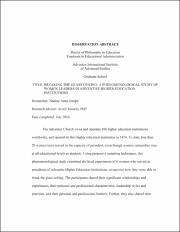| dc.description.abstract | The Adventist Church owns and operates 106 higher education institutions
worldwide, and opened its first higher education institution in 1874. To date, less than
20 women have served in the capacity of president, even though women outnumber men
at all educational levels as students. Using purposive sampling techniques, this
phenomenological study examined the lived experiences of 6 women who served as
presidents of Adventist Higher Education Institutions, to uncover how they were able to
break the glass ceiling. The participants shared their significant relationships and
experiences, their personal and professional characteristics, leadership styles and
practices, and their personal and professional barriers. Further, they also shared their
advice to women who aspire for top leadership positions, specifically as presidents at
Adventist Higher Education Institutions.
Data was collected through face-to-face interviews, FaceTime interviews,
observations/shadowing, field notes/researcher’s journal, the Leadership Practice
Inventory–Self by Kouzes and Posner (1995), demographic survey sheet, and curriculum
vitae. A total of 10 themes emerged—(a) influential persons in leadership development,
(b) childhood antecedents of leadership potential, (c) academic qualifications and
leadership experience, (d) shared personal and professional characteristics, (e) personal
barriers, (f) professional barriers, (g) managing barriers, (h) mixed leadership styles and
practices, (i) preparation, and (j) connectedness with God.
The findings revealed that the participants had positive experiences with parents,
teachers, role models, and male mentors who influenced their leadership development, in
addition to having clear indication that God had led them to the presidency. The
participants had high academic qualifications and significant leadership experiences prior
to serving as presidents. They also possessed personal and professional characteristics
that were consistently identified as characteristics of good leaders. Some of the personal
and professional barriers that emerged from the study differed from the results of
previous studies since the participants generally felt that they had few barriers while they
served as presidents. The participants used mixed leadership styles. All participants
reported using some aspects of transformational, participative/democratic, and
androgynous leadership approaches. A unique finding is that they also used overlapping
elements of servant leadership and transformational leadership even though they did not
identify themselves as servant leaders. The women leaders advised aspiring women to
ensure that they are prepared through their high academic qualifications and relevant
leadership experiences. They further counseled that these aspiring women should develop
a close connection with God and be ready to respond to His call for them to serve as
presidents.
A review of present literature suggests that there is an existent glass ceiling in the
Adventist educational system since out of 106 presidents worldwide, only 6 are women, a
disconcerting 5.66% representation. Analysis of the experiences of the participants in this
study, however, revealed that a different type of glass ceiling may exist in the Adventist
denomination since women reportedly did not struggle to earn the positions as presidents
but rather felt led by God to that role. It is, therefore, possible that invisible internal
structures, successful indoctrination of a mentally constructed glass ceiling, cultural
negation, historicity of Adventist education, and espoused views of the role that women
play in the church are some factors that may have contributed to the underrepresentation
of women as presidents and possibly have restrained women even from aspiring to serve
in that capacity. | |

